People’s Republic of Bangladesh
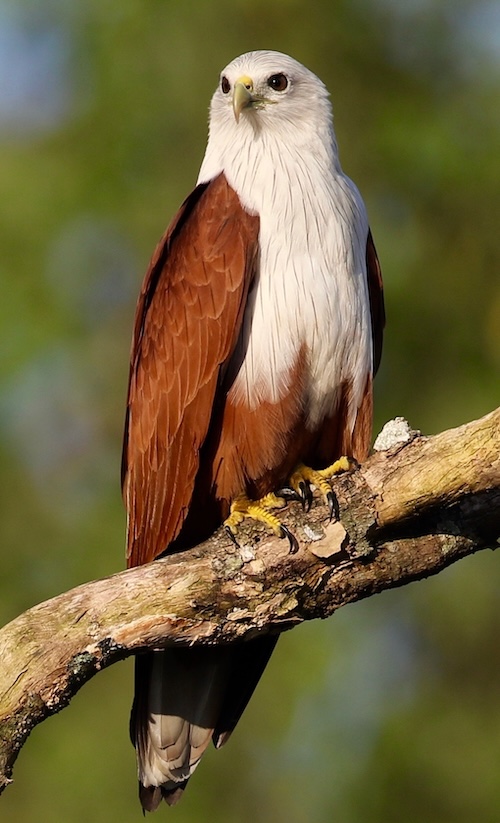
Bangladesh is a country in South Asia, which is constitutionally secular. It is bordered by India on all sides except for a small border with Burma (Myanmar) to the far southeast and by the Bay of Bengal to the south. Together with the Indian state of West Bengal, it makes up the ethno-linguistic region of Bengal. The name Bangladesh means ‘Country of Bengal’ in the official Bengali language. The capital and largest city is Dhaka, a mega city with a population of 24 million people (2024).
The borders of present-day Bangladesh were established with the partition of Bengal and India (1947), when the region became the eastern wing of the newly-formed Pakistan. However, it was separated from the western wing by 1,600 kilometres (1,000 miles) across India. Political and linguistic discrimination as well as economic neglect led to popular agitations against West Pakistan, which led to the war for independence (1971) and the establishment of Bangladesh, with the help of India. However, the new state had to endure famines, natural disasters and widespread poverty, as well as political turmoil and military coups. The restoration of democracy (1991) has been followed by relative stability and economic progress. It is among the most densely populated countries in the world with around 175 million people in an area of 148,460 km2 (57,320 square miles). It has a high poverty rate, although that has fallen by 20% since the early 1990s. Dhaka and other urban centres have been the driving force behind this growth. Geographically, the country straddles the fertile Ganges-Brahmaputra Delta and is subject to annual monsoon floods and cyclones.
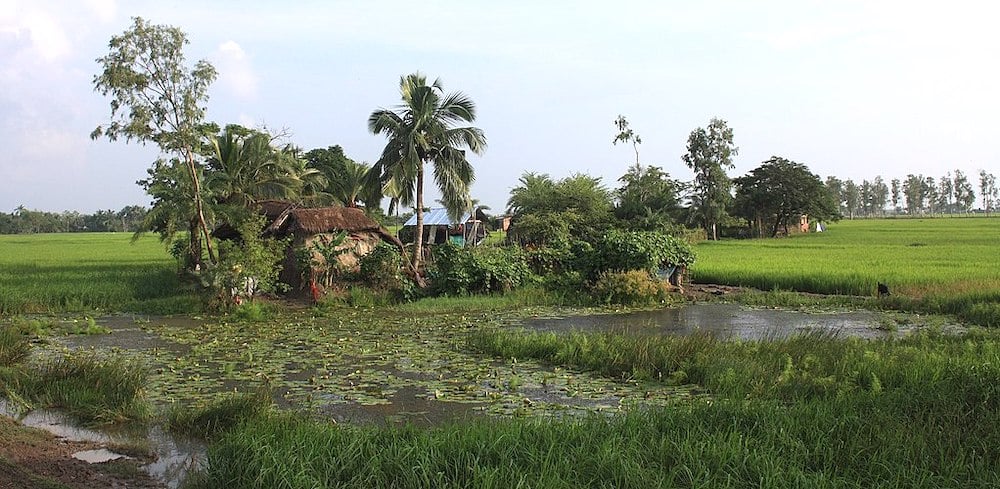
Ganges Delta, Sunderband – ©Arne Hückelheim, CC BY-SA 3.0 via Wikimedia Commons
The country is divided into three regions. Most of the country is dominated by the fertile Ganges Delta, the largest river delta in the world. The northwest and central parts of the country are formed by the Madhupur and the Barind plateaus. The northeast and southeast are home to evergreen hill ranges. This delta is formed by the confluence of the Ganges (local name Padma or Pôdda), Brahmaputra (Jamuna or Jomuna), and Meghna rivers and their respective tributaries. The Ganges unites with the Jamuna (main channel of the Brahmaputra) and later joins the Meghna to eventually empty into the Bay of Bengal. The alluvial soil deposited by these rivers has created some of the most fertile plains in the world. Bangladesh has 58 trans-boundary rivers, making water issues politically complicated to resolve – in most cases as the lower riparian state to India. Most parts of Bangladesh are less than 39 feet above sea level, and it is believed that about 50% of the land would be flooded if the sea level were to rise by just 3 feet.
The highest point in Bangladesh is in Mowdok range at 3,451 feet in the Chittagong Hill Tracts to the southeast of the country. Straddling the Tropic of Cancer, Bangladeshi climate is tropical with a mild winter from October to March, a hot, humid summer from March to June. A warm and humid monsoon season lasts from June to October that supplies most of the country’s rainfall. Natural calamities, such as floods, tropical cyclones, tornadoes, and tidal bores occur almost every year, combined with the effects of deforestation, soil degradation and erosion. Cox’s Bazar, south of the city of Chittagong, has a beach that stretches uninterrupted over 120 kilometres.
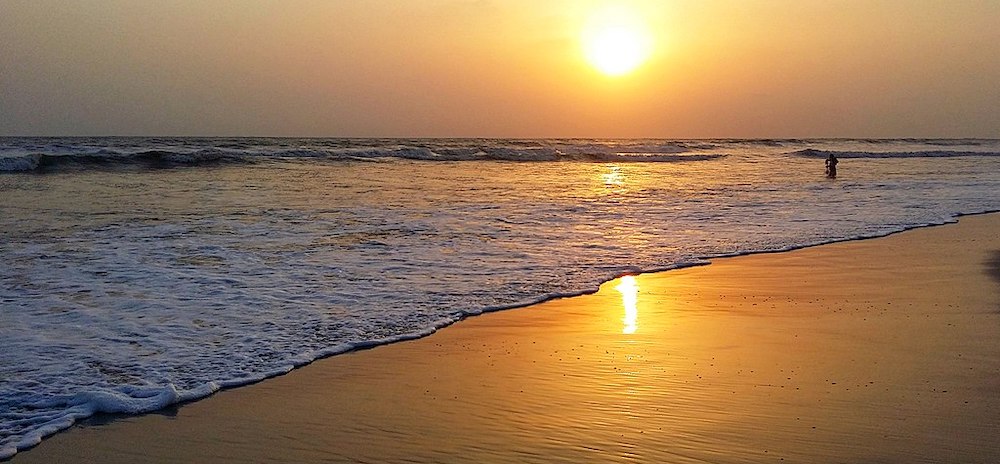
Cox’s Bazar – ©Imrul.kader, CC BY-SA 3.0 via Wikimedia Commons
Bangladesh had (1998) the most severe flooding in modern world history when the Brahmaputra, Ganges and Meghna spilt over and swallowed 300,000 houses, 9,700 km of road and 2,600 km of embankment. 1,000 people were killed and 30 million more were made homeless with 135,000 cattle killed, 50 square kilometres of land destroyed and 11,000 kilometres of roads damaged or destroyed. Two-thirds of the country was underwater. There were several reasons for the severity of the flooding. Firstly, there were unusually high monsoon rains. Secondly, the Himalayas shed off an equally unusually high amount of melt water that year. Trees that usually intercept rain water were cut down for firewood or to make space for animals!
Birding Bangladesh
A major part of the coastline comprises a marshy jungle, the Sundarbans, the largest mangrove forest in the world. It is home to diverse flora and fauna, including the Royal Bengal Tiger in a region that has itself been declared endangered. Bangladesh is located in the Indomalayan realm, and lies within four terrestrial eco-regions: Lower Gangetic Plains moist deciduous forests, Mizoram–Manipur–Kachin rain forests, Sundarbans freshwater swamp forests, and Sundarbans mangroves. ts ecology includes a long sea coastline, numerous rivers and tributaries, lakes, wetlands, evergreen forests, semi evergreen forests, hill forests, moist deciduous forests, freshwater swamp forests and flat land with tall grass. The Bangladesh Plain is famous for its fertile alluvial soil which supports extensive cultivation.
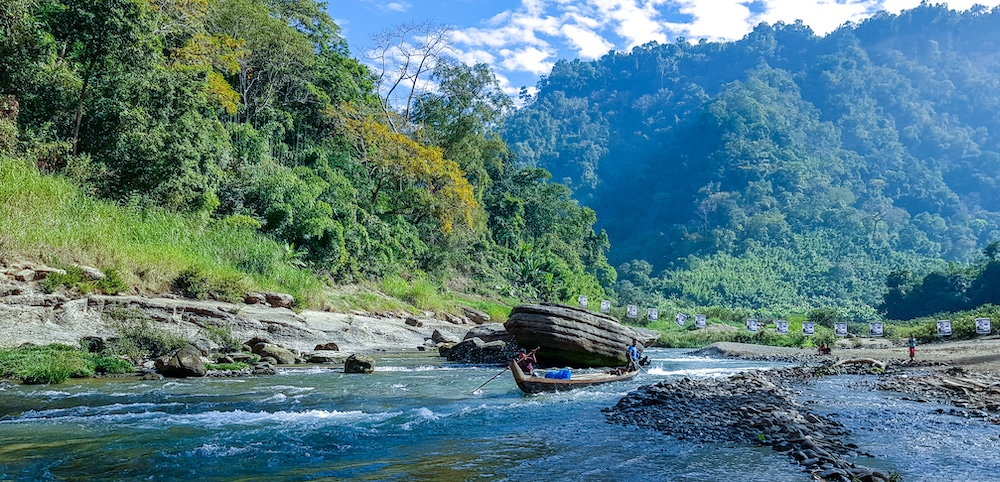
Sangu Wildlife Sanctuary – ©HAHoque, CC BY-SA 4.0 via Wikimedia Commons
The country is dominated by lush vegetation, with villages often buried in groves of mango, jackfruit, bamboo, betel nut, coconut, and date palm. The northeastern Sylhet region is home to haor wetlands, a unique ecosystem. It also includes tropical and subtropical coniferous forests, a freshwater swamp forest, and mixed deciduous forests. The southeastern Chittagong region covers evergreen and semi-evergreen hilly jungles. Central Bangladesh includes the plains-land Sal forest running along with the districts of Gazipur, Tangail, and Mymensingh. St. Martin’s Island is the only coral reef in the country.
Water bodies and wetland systems provide a habitat for many aquatic plants. Water lilies and lotuses grow vividly during the monsoon season. The country has 50 wildlife sanctuaries. Bangladesh has an abundance of wildlife in its forests, marshes, woodlands, and hills.

Baroiyadhala National Park – ©Ayub Parvez, CC BY-SA 4.0 via Wikimedia Commons
The vast majority of animals dwell within a habitat of 150,000 km2. Bengal Tiger, Clouded Leopard, Saltwater Crocodile, Black Panther and Fishing Cat are among the chief predators in the Sundarbans. Northern and eastern Bangladesh is home to the Asian Elephant, Hoolock Gibbon & Asian Black Bear. Chital deer are widely seen in southwestern woodlands. Other animals include Black Giant Squirrel, Capped Langur, Bengal Fox, Sambar Deer, Jungle Cat, King Cobra, Eild Boar, Mongooses, Pangolins, Pythons and Water Monitors. Bangladesh has one of the largest populations of Irrawaddy and Ganges Dolphins. The country has numerous species of amphibians (53), reptiles (139), marine reptiles (19) and marine mammals (5). It also has over 800 species of birds.
-
Wikipedia
GNU Free Documentation License
https://en.wikipedia.org/wiki/Bangladesh
-
Number of bird species: 828
(As at August 2024)National Bird: Oriental Magpie Robin (aka Doyel) Dopsychus saularis
-
Avibase
PDF ChecklistThis checklist includes all bird species found in Bangladesh , based on the best information available at this time. It is based on a wide variety of sources that I collated over many years. I am pleased to offer these checklists as a service to birdwatchers. If you find any error, please do not hesitate to report them. -
BRGB
PDF ChecklistBidiversity Research group of Bangladesh -
Wikipedia
Annotated ListThis is a list of the bird species recorded in Bangladesh. The avifauna of Bangladesh include a total of 827 species, of which two have been introduced by humans. Fifty-one species are globally threatened. -
eBird
PDF ChecklistThis checklist is generated with data from eBird (ebird.org), a global database of bird sightings from birders like you. If you enjoy this checklist, please consider contributing your sightings to eBird. It is 100% free to take part, and your observations will help support birders, researchers, and conservationists worldwide.
-
A Naturalist's Guide to the Birds of India
| Bangladesh, Bhutan, Nepal, Pakistan and Sri Lanka | By Bikram Grewal & Garima Bhatia | John Beaufoy Publishing | 2022 | Edition 2 | Paperback | 176 pages, 300+ colour photos, 1 colour map | ISBN: 9781913679347 Buy this book from NHBS.com -
A Photographic Field Guide to the Birds of India, Pakistan, Nepal, Bhutan, Sri Lanka, and Bangladesh
By Bikram Grewal, Sumit Sen, Sarwandeep Singh, Nikhil Devasar & Garima Bhatia | Princeton University Press | 2017 | Paperback | 792 pages, 4000+ colour photos, 1300+ colour distribution maps | ISBN: 9780691176499 Buy this book from NHBS.com -
A Photographic Guide to Birds of Bangladesh
By Ronald R Halder | Halder | 2010 | Paperback | 257 pages, 735 colour photos, colour distribution maps | Out of Print | ISBN: 9789843319258 Buy this book from NHBS.com -
A Photographic Guide to the Birds of India
| Including Nepal, Sri Lanka, Bhutan, Pakistan and Bangladesh | Amano Samarpan | Wisdom Tree | 2022 | Paperback | 160 pages, colour photos | Out of Print | ISBN: 9788183280297 Buy this book from NHBS.com -
Among the Birds of India
| A Photographic Guide – Including Nepal, Bhutan, Pakistan, Sri Lanka and Bangladesh | By Amano Samarpan | Wisdom Tree | 2029 | Paperback | 174 pages, colour photos | ISBN: 9788183285384 Buy this book from NHBS.com -
Birds of the Indian Subcontinent
By Richard Grimmett, Carol Inskipp & Tim Inskipp | Christopher Helm | Softcover | 2012 | Edition: 2 | 528 Pages | 226 Colour Plates | Colour Distribution Maps | Black & White Illustrations ISBN: 9781408127636 Buy this book from NHBS.com -
Feathered Splendours - Birds of Bangladesh
By Enam Ul Haque | Bangladesh University Press | 2014 | Hardback | 228 pages, 228 colour photos | ISBN: 9789845061384 Buy this book from NHBS.com -
Field Guide to the Birds of Bangladesh
| By Richard Grimmett, Paul Thompson & Tim Inskipp | Helm | 2021 | Paperback | 320 pages, 103 plates with colour illustrations; colour photos, colour & b/w illustrations, colour distribution maps | ISBN: 9781472937551 Buy this book from NHBS.com
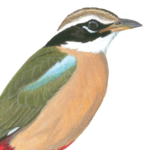
eGuide to Birds of the Indian Subcontinent
Apple iOS | AndroidThe eGuide to Birds of the Indian Subcontinent is an interactive companion to Birds of the Indian Subcontinent – the definitive guide for birdwatchers visiting the region. It covers India, Pakistan, Nepal, Bhutan, Bangladesh, Sri Lanka and the Maldives. This application has specific features that will enhance your birding experience. Please note that an additional download of 84MB is required once this app has been installed. Please ensure you use a WiFi connection to prevent additional data costsOrganisations-
Bangladesh Bird Club
WebsiteBangladesh bird club is an organization of people interested in the bird and its conservation in Bangladesh. It promotes the hobby of bird-watching, study of bird and conservation of wildlife and its habitats in Bangladesh. Through publications and promotional activities it seeks to raise public awareness on conservation issues in general and bird conservation in particular. -
Bangladesh Bird Club
Facebook PageBangladesh bird club is an organization of people interested in the bird and its conservation in Bangladesh. It promotes the hobby of bird-watching, study of bird and conservation of wildlife and its habitats in Bangladesh. Through publications and promotional activities it seeks to raise public awareness on conservation issues in general, and bird conservation in particular… -
Bangladesh Bird Watcher Society
Facebook PageBangladesh Bird Watcher Society is a member based non-profit organization founded in 2002, dedicated to study & conservation of bird in Bangladesh & region.
Reserves-
*List of protected areas of Bangladesh
InformationSatellite ViewInteractive list of Nature Reserves etc -
NP Bhawal
InformationSatellite ViewIt is located in Gazipur, Dhaka Division of Bangladesh, approximately 40 km north of Dhaka city, only 20 km drive from Gazipur and 20 km from Kapasia. The core area of the park covers 940 hectares but extends to 5,022 ha of surrounding forest. -
NP Kaptai
InformationSatellite ViewIt is about 57 kilometre from Chittagong city. It comprises with two Ranges namely Kaptai Range and Karnaphuli Range. t is a harbour of many wild birds. Notable birds are red junglefowl (Gallus gallus), kalij pheasant (Lophura leucomelanos), lineated barbet (Magalaima lineata), oriental pied hornbill (Anthracoceros albirostris), Indian roller (Coracias benghalensis), cattle egret (Bubulcus ibis), great egret (Casmerodius albus), greater racket-tailed drongo (Dicrurus paradiseus), jungle myna (Acridotheres fuscus), large blue flycatcher (Cyornis magnirostris) etc. -
NP Lawachara
InformationSatellite ViewThe park is located at Kamalganj Upazila, Maulvi Bazar District in the northeastern region of the country. It is located within the 2,740 ha (27.4 km2) West Bhanugach Reserved Forest. -
NP Ramsagar
InformationSatellite ViewIt is built around a large water reservoir known as "Ramsagar tank" built in the 18th century. -
NP Satchari
InformationSatellite ViewLiterally 'Satchari' in Bengali means 'Seven Streams'. There are seven streams flowing in this jungle, and the name 'Satchari' came from there. Wildlife in this park is rich. Red junglefowl, red-headed trogon, Oriental pied hornbill and pygmy woodpecker are some of them. The critically endangered hoolock gibbon also resides here. Also Phayre's leaf monkey, a species of langur also resides here. Asian black bear also resides here in small numbers. -
WS Chimbuk
InformationSatellite ViewChimbuk Wildlife Sanctuary is located in Bandarban. -
WS Chunati
InformationSatellite ViewChunati Wildlife Sanctuary is a major corridor for the movement of Asian Elephant between Bangladesh and Myanmar. Mammal species in the Sanctuary include muntjac deer, fishing cat, wild boar and Indian crested porcupine. Birds include the black-rumped flameback, coppersmith barbet, chestnut-headed bee-eater, green bee-eater, greater coucal, house swift, spotted dove, black drongo, jungle myna and Asian pied starling. -
WS Rema-Kalenga
InformationSatellite ViewThis is a dry and evergreen forest . It is located in the Chunarughat of Habiganj district. The forest currently has 37 species of mammals, 167 species of birds, seven species of amphibian, 18 species of reptiles and 638 species of plants. Specially, the forest is well known for a variety of rare bird species. -
WS Sangu Matamuhari
InformationSatellite ViewIt is part of the Sangu reserve forest. It houses Bangladesh's richest wildlife resource after Sunderbans. It is famous for its remoteness and for its rich array of wildlife, including great hornbills, crab-eating macaques, Asian elephants, sambar deer, Asian black bears, spotted owlets, leopards, clouded leopards, barking deer, Bengal monitors, dholes, and capped leaf monkeys/capped langurs. There have also been uncertain reports of vagrant tigers in the forest reserve by local indigenous people. -
WS Teknaf
InformationSatellite ViewIt is in the Cox's Bazar District of southern Bangladesh comprising a hill forest area of 11,615 ha (44.85 sq mi). In the east it is bordered by the Naf River, and in the west by the Bay of Bengal.This is one of the few places in Bangladesh where Asian elephants can be seen in the wild. -
WS WII IBA Sundarban Forest & Reserves
InformationSatellite ViewSundarbans East Wildlife Sanctuary, a protected forest in Bangladesh, extends over an area of 31,227 ha. of mangrove forest, Sundarbans West Wildlife Sanctuary is a UNESCO World Heritage Site and animal sanctuary is part of the larger Sundarbans region, one of the largest mangroveforests in the world and Sundarbans South Wildlife Sanctuary is a reserve forest in Bangladesh that extends over an area of 36,970 hectares of mangrove forest. It is situated next to the Sundarbans National Park in West Bengal, India. Birds are plentiful with over 270 having been recorded in the area including 38 species of raptor, 95 species of waterfowl and 9 of kingfishers. Some of the birds recorded such as the masked finfoot (Heliopais personatus) and the white-rumped vulture (Gyps bengalensis) are threatened globally. The greater spotted eagle (Clanga clanga) overwinters here but the lesser adjutant (Leptoptilos javanicus) is a resident but uncommon species as is the mangrove pitta (Pitta megarhyncha) and the black-headed ibis (Threskiornis melanocephalus). -
Wetlands
WebpageSatellite ViewBangladesh currently has 2 sites designated as Wetlands of International Importance (Ramsar Sites), with a surface area of 611,200 hectares.
Sightings, News & Forums-
eBird
SightingseBirding This Month
Guides & Tour Operators-
Bird Photo Tours ASIA
Tour OperatorBird-Photo-Tours Asia Bangladesh expedition is a photographic quest targeted at the Masked Finfoot with close encounters also possible with other speciality mangrove birds like Buffy Fish Owl, Brown-winged Kingfisher and Mangrove Pitta. -
BirdQuest
Tour OperatorBANGLADESH – Masked Finfoot, White-eared Night Heron, Cachar Bulbul & More -
BirdTour Asia
Tour OperatorThis tour is all about going in search of the Critically Endangered Masked Finfoot. A bird regularly seen in Thailand and Malaysia up until the turn of the century, it has since become one of the least-known and seldom-seen Asian species due to its steep decline – with fewer than 300 birds remaining, the majority of which are resident in the Bangladeshi Sundarbans. It’s also known to breed in out-of-bounds areas of northern Myanmar and Cambodia, the only accessible site where the bird can be readily encountered is the Sundarbans of Bangladesh. In fact, it's so rarely-seen, even Rob and James have only seen it twice between them! -
Birding Ecotours
Tour OperatorIf you want to join a Masked Finfoot tour, we will likely be running this just after our Complete Northern India birds and tigers tour in February 2025. -
BirdingBD Tours
Local Tour OperatorBirdingBD Tours can arrange tailormade trips for you in Bangladesh so you don’t have to worry about unnecessary Logistics and Planning and can concentrate on Watching Birds. -
Dhaka Holidays
Local Tour OperatorThrough this jungle safari tour the tourist can get a wonderful opportunity to explore the virgin rain forest and the tribal excellence in the north-eastern part of Bangladesh. -
Eco-Tourism Sundarban Forest Department
Local Tour OperatorPackage: Sundarbans Bird Watching Tour -
Royal Bengal Tours
Local Tour OperatorBirdwatching trip to Bangladesh is heavenly for the person who cares and loves spotting birds. There are over 700 species of birds found in the country. From migratory birds to endemic species, Bangladesh offers a unique bird watching experience for both amateur and professional bird-watchers. This trip is dedicatedly designed for bird lovers around the world that we operate once a year. -
Taabu Tour
Local Tour OperatorBangladesh is home to an impressive number of species of birds that vary from residents, that stay all year around, to breeding birds, that spend a good part of the growing season in Bangladesh to raise their young, migrants who pass through Bangladesh with the seasons, to wintering birds who like to spend a good part of the winter in Bangladesh to escape colder conditions up north.
Trip Reports-
2016 [03 March] - Mike Moore
PDF Report...We spent a great morning in Lawacharra NP following the trails which might be challenging to navigate on one’s own for lack of any kind of signage. Good birds spotted werre Asian Stubtail and Ashy Minivet amongst others, and we found Phayre’s Langur... -
2017 [01 January] - Lonnie Bregman
PDF Report...offshore lies Sonadia Island: the most reliable spot for Spoon-billed Sandpiper in Bangladesh. Originally this place was not part of our itinerary, because we thought we would have sufficient chances for this species during the AWC. However, in hindsight this was not as reliable as we thought and not going to Sonadia Island would have been a huge mistake! -
2022 [12 December] - Josh Beck
PDF Report...In the end, we all miraculously made it to Dhaka on schedule, nobody had any visa problems, our boat operator and the surrounding logistics were absolutely terrific, we had a hell of a good time, laughed ourselves sick, and we even saw two Masked Finfoots. It was a really great trip with an awesome group of friends... -
2023 [12 December] - OkamotoKeitaSin
Report...Soon after, we found a third bird, another female, that offered an unparalleled experience and photographic opportunity which we duly enjoyed. She was thankfully not as timid as the first two birds, and we actually ended up seeing her again every day for the next three days, even roosting...
-
Fatbirder - linking birders worldwide...
Skip to content

